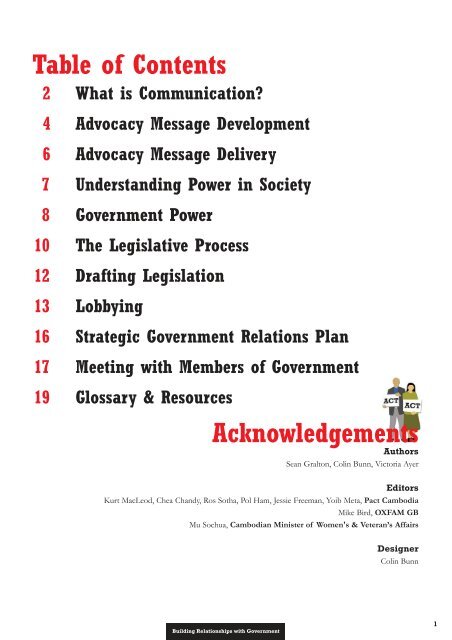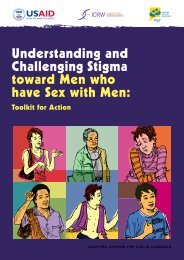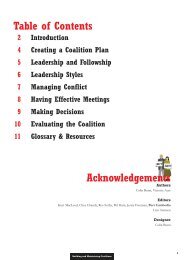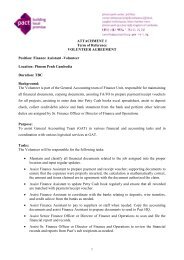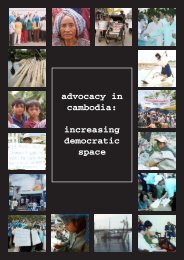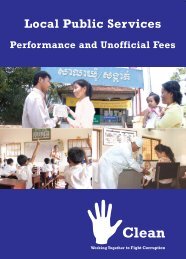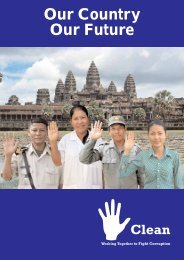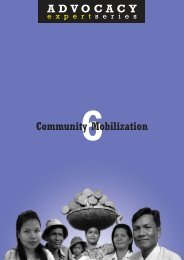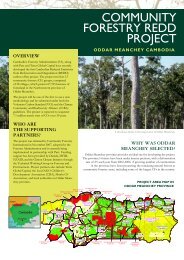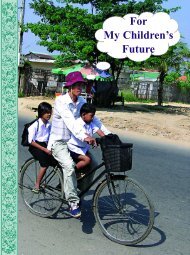Module 2 - edition - 28-05-2006.qxd - Pact Cambodia
Module 2 - edition - 28-05-2006.qxd - Pact Cambodia
Module 2 - edition - 28-05-2006.qxd - Pact Cambodia
Create successful ePaper yourself
Turn your PDF publications into a flip-book with our unique Google optimized e-Paper software.
Table of Contents<br />
2 What is Communication?<br />
4 Advocacy Message Development<br />
6 Advocacy Message Delivery<br />
7 Understanding Power in Society<br />
8 Government Power<br />
10 The Legislative Process<br />
12 Drafting Legislation<br />
13 Lobbying<br />
16 Strategic Government Relations Plan<br />
17 Meeting with Members of Government<br />
19 Glossary & Resources<br />
Acknowledgements<br />
Authors<br />
Sean Gralton, Colin Bunn, Victoria Ayer<br />
Editors<br />
Kurt MacLeod, Chea Chandy, Ros Sotha, Pol Ham, Jessie Freeman, Yoib Meta, <strong>Pact</strong> <strong>Cambodia</strong><br />
Mike Bird, OXFAM GB<br />
Mu Sochua, <strong>Cambodia</strong>n Minister of Women's & Veteran’s Affairs<br />
Designer<br />
Colin Bunn<br />
Building Relationships with Government<br />
1
Introduction<br />
Government officials, legislators, and their staff hold tremendous power over the success of advocacy campaigns. Their<br />
support or opposition can influence the direction of an advocacy campaign considerably. The purpose of this book,<br />
the second in our Advocacy Expert Series, is to examine how our Non-Governmental Organization (NGO) can build<br />
strong relationships with members of the government and persuade them to implement our advocacy goal.<br />
Communicating our Advocacy Campaign to Government<br />
The success of our advocacy campaign depends on our ability to persuade people in power to adopt our advocacy goal.<br />
In order to persuade people in power, we must understand how to communicate effectively and how power works.<br />
What is Communication?<br />
Communication is a method of transferring ideas to other people. These ideas can be simple such as, "We are poor" or<br />
"We are hungry". The ideas behind advocacy campaigns demand action: "Hire more teachers" or "Preserve our forests<br />
by enforcing the community forestry law."<br />
Communicating effectively is the foundation of our advocacy campaign. Through effective communication we can<br />
mobilize our supporters and persuade people in power to change or implement policy.<br />
How do we communicate effectively?<br />
We often communicate through speaking or writing. Though both are very good methods of communication, they are<br />
not always the most effective. Sometimes a single picture can convey a message as powerfully as 1,000 words. Or more<br />
relevant to our advocacy campaign, a rally of 1,000 people can be more effective than 1,000 words.<br />
A protest communicates through action<br />
A flyer communicates through writing<br />
To become good communicators we must first<br />
become good listeners.<br />
2<br />
Building Relationships with Government
What is Active Listening?<br />
All successful advocacy campaigns begin with actively listening to people in affected communities in order to understand<br />
their problems. Active listening is the process of truly hearing someone else's ideas and opinions. Active listening<br />
respects the person we are communicating with by showing that we are genuinely trying to understand their ideas and<br />
opinions. When we respect others’ ideas and opinions we can expect them to actively listen to us. Active listening also:<br />
• Affirms our understanding of what has been said to us.<br />
• Shows us what part of our message was not clear or not understood.<br />
• Assists in building a good working relationship. Everyone wants to know that their ideas and opinions are<br />
being heard and respected.<br />
How can we actively listen?<br />
To actively listen we need to:<br />
• Ask questions if we do not understand.<br />
• Restate what the other speaker has said, then ask if we restated it correctly.<br />
• Use eye contact and body language, such as nodding, to show that we are listening carefully.<br />
• Be patient so that the speaker has a chance to express themselves.<br />
During our campaign we will need to actively listen to anyone who receives our advocacy messages.<br />
ACTIVE LISTENING LOOP<br />
Speaker communicates idea.<br />
Listener receives idea from Speaker.<br />
SPEAKER<br />
LISTENER<br />
Speaker receives feedback from Listener.<br />
Listener communicates feedback.<br />
Giving and receiving feedback<br />
is the key to active listening.<br />
Building Relationships with Government<br />
3
Advocacy Message Development<br />
Everyday, we receive many messages from many sources - radio, television, newspapers, advertisements, classes, workshops,<br />
meetings, even our friends and family - but we can only process a limited amount of information at a time. The<br />
targets of our advocacy campaign ("stakeholders" with high influence over the goal of our advocacy campaign) are no<br />
different.<br />
To communicate our advocacy messages effectively we need to carefully select the content, language, and brand of<br />
our messages.<br />
Content What is our campaign about? What arguments will we use to convince our targets?<br />
The content of our advocacy messages must be:<br />
SIMPLE<br />
Our advocacy campaign should have one main message and no more than three supporting messages. If we have any<br />
more, we will lose the attention of our targets.<br />
SHORT<br />
Messages are ideas that can be explained in a sentence or two. If we need to use a paragraph or more, we should<br />
shorten our message.<br />
RELEVANT<br />
Our message should always support our organization's main advocacy goal.<br />
CLEAR<br />
The most effective methods of communication are those that cannot be misinterpreted. For example:<br />
a baby might cry<br />
because the baby is<br />
tired or hungry...<br />
a moto might not<br />
start because it<br />
is out of gas, or<br />
the battery has<br />
died...<br />
A red traffic light, however, can only<br />
mean stop - it cannot be misinterpreted.<br />
Our advocacy message should be as clear<br />
as a traffic light.<br />
4<br />
Building Relationships with Government
Language<br />
What keywords will we use to reach our targets? What words must we avoid?<br />
The language in our advocacy messages must be:<br />
STATEMENTS OF IDEAS<br />
A message should be a complete thought capable of<br />
being understood quickly and easily. We can also use<br />
imagery, colorful language, and vivid details to increase<br />
the impact of our message.<br />
CONSISTENT<br />
Messages will need to be repeated over and over again<br />
before they are heard and understood. We should use<br />
similar language in all of our messages if we want our<br />
targets to associate the words with our campaign.<br />
FOCUSED<br />
Our messages should be focused on specific targets and<br />
tailored to respect their preferences. This does not mean<br />
changing the content of our message but rather changing<br />
the way we present it. Never use harmful or offensive<br />
language.<br />
ORIGINAL MESSAGE<br />
"End discrimination against<br />
the 2.6% of adults in<br />
<strong>Cambodia</strong> who are HIV positive."<br />
"35,000 children die every<br />
day from malnutrition. We<br />
must work to end the global<br />
malnutrition crisis."<br />
IMPROVED MESSAGE<br />
"Imagine if every single<br />
person in Kompong Som<br />
province had HIV/AIDS. We<br />
cannot afford the economic<br />
costs of discriminating against<br />
170,000 people."<br />
"100 jumbo jets crash<br />
with 350 children aboard<br />
every day. Help stop the malnutrition<br />
crisis."*<br />
* from UNICEF's "silent emergency" campaign.<br />
Brand<br />
What kind of visual statement can we make to communicate our ideas?<br />
Not all messages must be communicated with language. “Branding” our advocacy campaign by using graphic images<br />
(like symbols and logos) can communicate our advocacy messages quickly and clearly. Like the language of our advocacy<br />
messages, brands must be used over and over again for them to be recognized.<br />
The most successful advocacy messages<br />
inspire people to take action.<br />
Building Relationships with Government<br />
5
Advocacy Message Delivery<br />
Once we have chosen the content, language, and brand for our main and supporting messages we need to decide how<br />
to deliver our messages.<br />
NOTE:<br />
All messages must have a messenger. A messenger speaks on behalf of our If we choose a messenger who is<br />
advocacy campaign. Often the best messenger for our advocacy message is famous it is important to consider their<br />
political affiliation. Their political affiliation<br />
may affect the acceptability of our<br />
someone who is personally affected by the problem. In certain situations,<br />
however, some messengers are more effective than others. A representative message with our target audience.<br />
from our NGO is an effective messenger when we want to closely control our message and need to show credibility. A<br />
famous spokesperson such as a popular singer or television actor is an effective messenger when we want to increase<br />
our messages' appeal to a broader audience.<br />
MESSENGERS<br />
Beneficiaries<br />
Members of the affected<br />
group (called "beneficiaries")<br />
are excellent messengers<br />
because they can provide<br />
personal stories and<br />
firsthand accounts of the<br />
problem.<br />
NGO Employee<br />
NGO Employees are appropriate<br />
messengers when<br />
we want to convey credibility<br />
and control our advocacy<br />
messages carefully.<br />
Mascots<br />
Mascots are excellent messengers<br />
when we want to<br />
communicate to children or<br />
if our message deals with a<br />
culturally sensitive problem.<br />
(PHOTO: PSI’s Number One<br />
Condom.)<br />
Celebrity<br />
Celebrities are excellent<br />
messengers when we want<br />
to broaden the appeal of<br />
our message or appeal to<br />
different sectors of society.<br />
(PHOTO: Neay Koy, a popular<br />
<strong>Cambodia</strong>n Comedian, gets his<br />
blood tested to support HIV/AIDS<br />
awareness.)<br />
It is our responsibility to educate our messengers about the proper format, time, and place to deliver our advocacy<br />
message.<br />
Format How will we disseminate our message?<br />
When choosing the format for our advocacy message, we must look at the preferences of the targets of our advocacy<br />
campaign. It is important to use language and images that our targets will recognize and understand. For example, when<br />
communicating to illiterate adults, radio broadcasts or illustration books might be the most effective message formats.<br />
When communicating to the members of government we need to prepare professional looking briefing papers (see<br />
page 17.)<br />
Time and Place When and where should we disseminate our message?<br />
We should disseminate our messages at a time and place that best matches the lives our targets. If we want to communicate<br />
to factory workers, for example, we should meet employees outside the factory gates at closing time or shift<br />
changes. To communicate to members of government, we should plan face to face meetings in their office or constituency<br />
where we can have their full attention (see page 17.) These meetings should be scheduled during a calm period,<br />
not during a major political crisis.<br />
6<br />
Building Relationships with Government
Understanding Power in Society<br />
Power is the ability to control or influence someone or something. We need to understand power because successful<br />
advocacy campaigns lead to changes in power relationships in society.<br />
The three spheres of society, the state, private sector, and civil society, share power although not always equally.<br />
The State: The state is made up of public entities working to advance public<br />
interests. Source of Power: Law<br />
Private sector: The private sector consists of private people and organizations<br />
working to advance private interests. Source of Power: Money<br />
Civil society: Civil society is made up of private citizens and organizations<br />
working together to advance public interests. An NGO is a part of civil society.<br />
Through our advocacy campaign we are helping to build the power of civil society in<br />
governance. Source of Power: Community<br />
As advocates, we will use power to influence different people within the three spheres of society to address problems<br />
in our communities.<br />
Finding Power<br />
Everyone wants to feel powerful. Understanding what makes us feel powerful will help us understand how to influence<br />
other people.<br />
When we feel disrespected, isolated, or that a problem is<br />
beyond our control, we have a better chance of regaining<br />
power if we find other people or organizations, form a relationship<br />
with them, and address the problem together.<br />
Power through Community Mobilization<br />
Community mobilization means gathering people together to take a joint<br />
action. Strikes, marches, petition drives, forums and rallies are some common<br />
forms of community mobilization. NGOs assist communities to mobilize in<br />
order to change feelings of powerlessness into feelings of power.<br />
What makes us feel...<br />
Powerful?<br />
Having control<br />
Being treated with respect<br />
Solving difficult problems<br />
Working with others<br />
Causing others to fear us<br />
Having others support us<br />
Powerless?<br />
Lack of control<br />
Being disrespected<br />
Inability to fix problems<br />
Feeling isolated<br />
Feeling afraid<br />
Lack of resources<br />
NOTE:<br />
Expressing our message on billboards,<br />
banners, etc. is called "raising<br />
awareness." "Community mobilization"<br />
requires that people act.<br />
Six Steps for a Successful Protest<br />
1. Create a message that clearly states the issue we are protesting.<br />
2. Inform the authorities about the protest and secure legal permission.<br />
3. Invite our friends, champions, and other allies and make sure they show up.<br />
4. Set a time to start and stop the protest. Select a clear route for protesters to follow.<br />
5. Keep the attention of the crowd and the media with signs, chants, songs and entertainment.<br />
6. Have a security plan to make sure the participants will be safe and peaceful.<br />
Building Relationships with Government<br />
7
Government Power<br />
In order to use our power to persuade the members of government, we need to understand the structure of government<br />
and the legislative process. <strong>Cambodia</strong> is a democratic constitutional monarchy. This means that the King holds the<br />
ultimate power over the three other parts of the Government: the Council of Ministers, National Assembly, and Senate.<br />
Government Structure<br />
of<br />
CAMBODIA<br />
Council of<br />
the Crown<br />
King<br />
Prime Minister<br />
President of the<br />
National Assembly<br />
President of the<br />
Senate<br />
Council of<br />
Ministers<br />
National<br />
Assembly<br />
Senate<br />
Permanent<br />
Committee<br />
Permanent<br />
Committee<br />
Agriculture,<br />
Forestry, and<br />
Fisheries<br />
Environment<br />
Interior<br />
Commerce<br />
Foreign Affairs<br />
and International<br />
Cooperation<br />
Justice<br />
Ministries Commissions Commissions<br />
Culture and<br />
Fine Arts<br />
Health<br />
Land Management,<br />
Urban Planning, and<br />
Construction<br />
Economy and<br />
Finance<br />
Industry,<br />
Mines, and<br />
Energy<br />
National<br />
Defense<br />
Education,<br />
Youth, and<br />
Sports<br />
Information<br />
National Assembly-<br />
Senate Relations<br />
and Inspecton<br />
Human Rights,<br />
Reception of<br />
Complaints<br />
Investigation<br />
and National<br />
Assembly-Senate<br />
Relation<br />
Legislation<br />
and Justice<br />
Economy,<br />
Finance,<br />
Banking,<br />
and Audit<br />
Planning<br />
Investment<br />
Ariculture Rural<br />
Development<br />
Environment and<br />
Water Resources<br />
Education, Youth<br />
Sport, Religious<br />
Affairs, Culture<br />
and Tourism<br />
Interior,<br />
National Defense,<br />
Investigation,<br />
Anti-Corruption<br />
and Public Function<br />
Public Health,<br />
Social Work,<br />
Veteran Youth<br />
Rehabilitation,<br />
Labor, Vocational<br />
Training and<br />
Women’s Affairs<br />
Foreign Affairs,<br />
International<br />
Cooperation,<br />
Information<br />
and Media<br />
Pulic work,<br />
Transport,<br />
Telecommunication,<br />
Post, Industry,<br />
Mine, Energy,<br />
Commerce, Land<br />
Management,<br />
Urban Planning<br />
and Construction<br />
Human Rights,<br />
Reception of<br />
Complaints<br />
Investigation<br />
and National<br />
Assembly-Senate<br />
Relation<br />
Legislation<br />
and Justice<br />
Economy,<br />
Finance,<br />
Banking,<br />
and Audit<br />
Planning<br />
Investment<br />
Ariculture Rural<br />
Development<br />
Environment and<br />
Water Resources<br />
Education, Youth<br />
Sport, Religious<br />
Affairs, Culture<br />
and Tourism<br />
Interior,<br />
National Defense,<br />
Investigation,<br />
Anti-Corruption<br />
and Public Function<br />
Public Health,<br />
Social Work,<br />
Veteran Youth<br />
Rehabilitation,<br />
Labor, Vocational<br />
Training and<br />
Women’s Affairs<br />
Foreign Affairs,<br />
International<br />
Cooperation,<br />
Information<br />
and Media<br />
Pulic work,<br />
Transport,<br />
Telecommunication,<br />
Post, Industry,<br />
Mine, Energy,<br />
Commerce, Land<br />
Management,<br />
Urban Planning<br />
and Construction<br />
Planning<br />
Post and Public Works and<br />
Telecommunication Transport<br />
Cults and<br />
Religions Affairs<br />
Rural<br />
Development<br />
Social Affairs<br />
Veteran and Youth<br />
Rehabilitation<br />
Tourism<br />
Water Resources<br />
and Meteorology<br />
Women Affairs<br />
Labor and<br />
Vocational<br />
Training<br />
8<br />
Building Relationships with Government
What is democracy?<br />
Democracy is a system of governance<br />
where the people, either directly or<br />
through elected representatives, have<br />
the right and power to change policies<br />
or practices to improve society.<br />
In a democracy, members of civil society have the right and duty to tell government<br />
officials how a government is functioning. It is the role of civil society to encourage<br />
fair legislative and election processes and monitor them both closely.<br />
Executive Branch<br />
The King of <strong>Cambodia</strong> is the head of state for life. “The King reigns<br />
but does not govern.”<br />
Constitutional<br />
Council<br />
Supreme<br />
Council of<br />
Magistracy<br />
The Council of the Crown's primary function is to determine the<br />
succession of the crown. Unlike other monarchies, the royal line does<br />
not automatically descend through the eldest child of the King. The<br />
Council consists of two Buddhist patriarchs and seven of the highest<br />
ranking politicians.<br />
The Council of Minister’s, also known as the Royal Government of<br />
<strong>Cambodia</strong>, primary function is to implement laws and policies that<br />
will govern <strong>Cambodia</strong>. Its members include the Prime Minister,<br />
Deputy Prime Minister(s), Senior Ministers, the Minister of each<br />
Ministry, and the Secretaries of State.<br />
Legislative Branch<br />
The National Assembly's primary function is to adopt laws that will<br />
govern <strong>Cambodia</strong> and to elect the Prime Minister. The members of<br />
the National Assembly are elected by the citizens of <strong>Cambodia</strong> and<br />
serve 5 year terms.<br />
President of the<br />
Supreme Court<br />
The Permanent Committee of the National Assembly's primary<br />
function is to set the legislative agenda for the National Assembly.The<br />
Committee consists of the Presidents of each Commission.<br />
Supreme<br />
Court<br />
Appellate<br />
Court<br />
Courts<br />
Municipal Provincial Military<br />
The Senate's primary function is to review all laws passed by the<br />
National Assembly and to propose its own legislation. Some of<br />
Senators shall be appointed and some others shall be elected by<br />
non-universal election.<br />
The Permanent Committee of the Senate's primary function is to set<br />
the legislative agenda for the Senate. The Committee consists of the<br />
Presidents of each Commission.<br />
Judicial Branch<br />
The Supreme Court is the highest court of appeals in the country. Its<br />
jurisdiction covers the whole territory of <strong>Cambodia</strong>.<br />
The Appellate Court hears all cases appealed from the municipal,<br />
provincial, and military courts.<br />
The Supreme Council of the Magistracy's primary function is to<br />
ensure the smooth functioning of the judiciary. Its 9 members include:<br />
- the King<br />
- the Minister of Justice<br />
- the President of the Supreme Court<br />
- the Prosecutor-General of Supreme Court<br />
- the President of the Appellate Court<br />
- the Prosecutor-General of Appellate Court<br />
- Judges elected by the Judges themselves.<br />
The Constitutional Council's primary function is to determine the<br />
constitutionality of laws and it shall have the right to examine and<br />
decide on contested cases involving the election of Assembly and<br />
Senate members. Its nine members are chosen by the National<br />
Assembly, the King, and the Supreme Council of the Magistracy.<br />
Building Relationships with Government<br />
9
The Legislative Process<br />
The legislative process describes how a draft proposal becomes a law. All democratic nations have their own legislative<br />
process. Imagine that we want to pass a law about land reform in <strong>Cambodia</strong>. This is how the draft would proceed:<br />
2 4 6<br />
The Legislative Working<br />
Group within the Ministry<br />
will examine and edit the<br />
draft law. They will approach<br />
the Council of Jurists for<br />
their input.<br />
The Legislative Working Group within<br />
the Ministry will examine and edit the<br />
draft law. They will approach the Council<br />
of Jurists for their input.<br />
The President of the National Assembly<br />
hands the draft law and the Statement of<br />
Cause to the Permanent Committee of the<br />
National Assembly.<br />
1 3<br />
A member of the Ministry<br />
of Land Management,<br />
Urban Planning, and<br />
Construction submits our<br />
land reform draft law for<br />
consideration to the<br />
Ministry's Legislative<br />
Working Group.<br />
The Council of Jurists examines the<br />
draft legislation and consults with the<br />
Legislative Working Group to clarify<br />
the legal issues related to the law.<br />
Once completed, they submit it to the<br />
Inter-Ministerial Committee.<br />
5 7<br />
The Council of Ministers reviews<br />
the draft law. If approved, the Prime<br />
Minister submits the law and a<br />
Statement of Cause to the President<br />
of the National Assembly.<br />
The Permanent<br />
Committee reviews<br />
the draft or proposed<br />
law and forwards it to<br />
the appropriate<br />
Commission.<br />
Civil Society plays an important role in fighting injustice and inequality by using the legislative process<br />
by Drafting Legislation and Lobbying government officials.<br />
10<br />
Building Relationships with Government
How a Draft bill becomes law in<br />
CAMBODIA<br />
8 9<br />
The selected Commission<br />
reviews the draft/proposed<br />
law and either:<br />
1. Recommends that the full<br />
Assembly not consider the<br />
legislation.<br />
2. Requests that the full<br />
Assembly decide whether<br />
to consider the legislation.<br />
3. Requests that the full<br />
Assembly consider the<br />
legislation on an "emergency"<br />
basis.<br />
If approved by the National<br />
Assembly, the President of<br />
the National Assembly<br />
delivers the draft/proposed<br />
law to the President of the<br />
Senate.<br />
11 13<br />
The Permanent<br />
Committee reviews the<br />
draft or proposed law and<br />
forwards it to the appropriate<br />
Commission.<br />
The Senate and the National Assembly<br />
send the draft/proposed law back and<br />
forth to make final changes to the<br />
draft/proposed law. If approved by the<br />
Senate and the National Assembly one<br />
last time, the President of the National<br />
Assembly delivers the draft/proposed<br />
law to the King.<br />
15<br />
The King signs a<br />
Royal Decree turning<br />
the draft/proposed<br />
law into a real law.<br />
10 12<br />
The President of the<br />
Senate hands the<br />
draft/proposed law to the<br />
Permanent Committee of<br />
the Senate.<br />
The selected Commission<br />
reviews the draft/proposed<br />
law and either:<br />
1. Recommends that the full<br />
Assembly not consider the<br />
legislation.<br />
14<br />
The Constitutional Council has the<br />
power to interpret whether a law<br />
passed by the National Assembly and<br />
fully reviewed by the Senate is constitutional.<br />
2. Requests that the full<br />
Assembly decide whether<br />
to consider the legislation.<br />
3. Requests that the full<br />
Assembly consider the<br />
legislation on an "emergency"<br />
basis.<br />
Effective laws change people's behavior and have a real impact on people's lives. A law - or the lack of law - can cause<br />
injustice and inequality in three ways:<br />
Words<br />
The law or policy explicitly denies fundamental<br />
rights or is discriminatory.<br />
Example: Women are not allowed to<br />
vote.<br />
Behavior<br />
The law or policy is not enforced or the<br />
law is implemented in a way that<br />
unfairly favors some people over others.<br />
Example: Everyone must pay taxes<br />
except government officials.<br />
Custom<br />
The public may be unaware of the law<br />
or customs, traditions, common practice<br />
make it difficult to enforce.<br />
Example: Families of murder victims<br />
accept payment from the criminals<br />
instead of cooperating with prosecutors.<br />
Building Relationships with Government<br />
11
Drafting Legislation<br />
Drafting legislation requires that we first define whose behavior is causing the problem. We can start by listing all of<br />
the people involved in creating the problem. The most important question to ask ourselves is, "Whose behavior needs<br />
to change in order for the problem to end?"<br />
For example, domestic violence legislation could mandate punishment for the abusers. But, we must also examine how<br />
behavior of police, judges, government officials, prosecutors, hospitals, or anyone else who may be involved with the<br />
problem needs to change.<br />
After we have defined whose behavior we need to change, we can then explore all possible legislative solutions. Start by<br />
researching all relevant laws, drafts and reports. Government departments at the national, regional, and local level are<br />
obvious resources for information. Below is a list of some others:<br />
LEGISLATIVE RESEARCH RESOURCES<br />
Universities<br />
Legal Journals<br />
Journalists<br />
Research Institutions<br />
Media Articles<br />
International Donors<br />
Libraries<br />
Other NGOs<br />
Internet<br />
When conducting research on legislation it is often helpful to look to other governments for an international perspective<br />
on the problem. Other governments may have more experience or expertise in regards to the problem and therefore<br />
may have already incorporated international best practices into their legislation. However, it is important to remember<br />
that although other countries may have already implemented a legislative solution for a problem like ours, laws and<br />
culture interact closely. What works for one group of people or society may not work for another. Our draft legislation<br />
must be more than just a translation of another law - it must reflect the needs of our community.<br />
The best way to find out the needs of our community is to ask them! For example, is there general consensus among<br />
the community and the general public that the law needs to be changed? How might our proposed changes to the law<br />
affect different segments of society? Many research methods (surveys, interviews, observations, etc.) can be used to help<br />
educate us about how people perceive the current law and our proposed solution.<br />
Once we have conducted a thorough investigation of all possible options we<br />
can begin to develop our own legislative solution. We must involve key stakeholders,<br />
politicians and political party members early in the process to incorporate<br />
their ideas and gain their support. Our draft legislation does not need<br />
to be perfect. It will be revised by experienced legislators and legal advisors<br />
many times throughout the legislative process.<br />
NOTE:<br />
As we conduct our research we must<br />
consider the reliability and accuracy of<br />
the information we discover. The credibility<br />
of our draft law will depend on<br />
thorough research, objective analysis,<br />
and proper documentation.<br />
As the draft law passes through the legislative process it is important to track the progress and ensure that any changes<br />
or amendments support our original advocacy goals. If the changes to the draft law are extreme, we may decide to withdraw<br />
our support for the law. By lobbying key decision makers in government we can promote the passage of our draft<br />
law.<br />
12<br />
Building Relationships with Government
Lobbying<br />
Lobbying is the art of persuading public officials to support or<br />
oppose a law and the enforcement of that law. In an advocacy campaign<br />
that seeks legislative change, lobbying is a critical part of our<br />
advocacy activities.<br />
How do I lobby effectively?<br />
To lobby government officials, we must prepare our messages and<br />
NOTE:<br />
Advocates sometimes confuse the words "lobbying"<br />
and "advocacy." Successful advocacy<br />
campaigns use many activities such as workshops,<br />
demonstrations, marches, and meeting<br />
with government officials to achieve their advocacy<br />
goals. Only meetings with government<br />
officials is called lobbying. Lobbying is just one<br />
of the methods we will use to accomplish our<br />
advocacy goal.<br />
messengers carefully. We must also identify the different types of legislators in positions of power.<br />
Legislators can be divided up into five types. Each type requires a different communication strategy:<br />
5 TYPES OF LEGISLATORS<br />
TYPE DESCRIPTION COMMUNICATION STRATEGY<br />
Champion<br />
Champions are legislators who<br />
believe in our advocacy campaign and<br />
actively support it. They will deliver<br />
our advocacy messages to other legislators<br />
and be visible spokespersons<br />
for the campaign.<br />
Provide Champions with reliable<br />
information that they can use to convince<br />
other legislators to join our<br />
cause.<br />
Friend<br />
Friends are legislators who support<br />
our advocacy campaign but who have<br />
not yet participated or contributed<br />
very much.<br />
Try to convince Friends to get more<br />
involved in our campaign.<br />
Fence-Sitter<br />
Fence sitters are legislators who are<br />
neutral and uncommitted to either side<br />
of our issue.<br />
Fence Sitters are the main targets of<br />
our lobbying efforts. We need to use<br />
our Friends and Champions to win<br />
them over to our side.<br />
Opponent<br />
Opponents are legislators who will<br />
definitely vote against us but do not<br />
have the time, resources or desire to<br />
work against us.<br />
Try to prevent Opponents of our advocacy<br />
campaign from becoming more<br />
active and vocal.<br />
Enemy<br />
Enemies are the people actively<br />
opposed to our advocacy goal.<br />
We must give clear reasons why other<br />
legislators should not join our<br />
Enemies.<br />
Who are our champions and friends<br />
within the government?<br />
Building Relationships with Government<br />
13
Lobbying<br />
Various communication strategies should be used in our lobbying activities. The chart below describes various points in<br />
the legislative process when members of government are more likely to listen to our views on draft legislation.<br />
LOBBY HERE!<br />
Members of the Ministries and their staff begin<br />
drafting a law. The Ministry may open the legislative<br />
process to civil society through workshops,<br />
forums, and public debates.<br />
LOBBY HERE!<br />
The Prime Minister is one of the most powerful<br />
people in Government. If we can convince the<br />
Prime Minister that our draft law is important,<br />
other members of Government will follow.<br />
Legislation does not have to begin in a Ministry.<br />
Any member of the National Assembly or Senator<br />
can propose legislation.When a member of the National<br />
Assembly or a Senator proposes legislation it is called a<br />
“Proposed Law” NOT a “Draft Law.” The Proposed Law<br />
follows the exact same steps as a Draft Law except that it<br />
is first introduced to a Commission within the National<br />
Assembly.<br />
LOBBY HERE!<br />
The Permanent Committee of the National Assembly<br />
and any commission within the National Assembly<br />
can initiate the legislative process. Like the Ministries,<br />
the Commissions may open the legislative process to<br />
civil society through workshops, forums, and public<br />
debates.<br />
14<br />
Building Relationships with Government
How do I pressure government officials?<br />
Write letters or emails<br />
Make phone calls<br />
Schedule face to face meetings<br />
Sign petitions<br />
Hold rallies or marches<br />
Invite them to public debates<br />
Involve international stakeholders<br />
Start a media campaign<br />
Invite government officials to visit<br />
the affected group<br />
LOBBY HERE!<br />
Senators have the power to debate and vote on legislation.<br />
Contact them and persuade them to adopt<br />
your position.<br />
LOBBY HERE!<br />
The President of the National Assembly is another one of the<br />
most powerful people in Government. If we can convince the<br />
President of the National Assembly that our draft bill is important,<br />
many times other members of the legislature will follow.<br />
LOBBY HERE!<br />
Although the King “reigns but does not govern”<br />
he plays an important role in <strong>Cambodia</strong>n politics<br />
and society.<br />
Building Relationships with Government<br />
15
Strategic Government Relations Plan<br />
Once we have identified the different types of legislators involved in our advocacy effort we can create a Strategic<br />
Government Relations Plan.<br />
A Strategic Government Relations Plan details our methods for persuading government officials to address our advocacy<br />
campaign. It will be integrated with our Advocacy Action Plan to keep our advocacy campaign activities focused<br />
and on track.<br />
SAMPLE GOVERNMENT RELATIONS PLAN<br />
Objective: Adoption and implementation of a Domestic Violence Law within five years.<br />
LAW, POLICY, OR<br />
PRACTICE TO BE<br />
CHANGED<br />
DECISION MAKERS<br />
TO BE TARGETED<br />
PUBLIC<br />
PERCEPTION OF<br />
THE LAW<br />
ACTIVITIES TO<br />
INFLUENCE<br />
TARGETED<br />
DECISION MAKERS<br />
CHAMPION<br />
YEAR 1-2<br />
A law making<br />
domestic violence a<br />
crime is adopted<br />
National Assembly<br />
Senate<br />
King<br />
Public has basic<br />
understanding of the<br />
problem of domestic<br />
violence but little<br />
awareness of their<br />
legal rights.<br />
Media has greater<br />
knowledge.<br />
Review current draft law. In<br />
consultation with stakeholders,<br />
develop suggestions to<br />
improve Draft Law, including<br />
removal of marital rape<br />
exception.<br />
Prepare briefing paper. Meet<br />
with chairs of Legislation and<br />
Health Care, Social Affairs,<br />
Work and Women's Affairs<br />
Commissions in Senate and<br />
National Assembly.<br />
Organize tour of domestic<br />
violence shelters to allow legislators<br />
to observe and meet<br />
beneficiaries.<br />
Meet with Prime Minister,<br />
Council of Ministers and<br />
King.<br />
Ms. Mu Sochua,<br />
Minister of Women's<br />
and Veteran's Affairs<br />
Organize candlelight vigils<br />
against violence in each<br />
province during 16-day campaign<br />
and invite legislators to<br />
speak.<br />
Conduct comparative analysis<br />
to examine how other<br />
countries implement their<br />
Domestic Violence laws.<br />
YEAR 3-5<br />
Domestic Violence<br />
Law is properly<br />
Minister of Interior<br />
Minster of Justice<br />
Law has not been<br />
passed<br />
In consultation with<br />
<strong>Cambodia</strong>n Bar Association<br />
and other stakeholders,<br />
develop draft Guidelines that<br />
will detail the best practices<br />
that police, prosecutors, and<br />
courts should follow when<br />
investigating and bringing<br />
cases to court.<br />
Ms. Khim<br />
Chamrouen<br />
implemented<br />
Meet with Ministers or<br />
Secretaries of State in Interior<br />
and Justice to lobby for adoption<br />
of Guidelines by the<br />
Ministries.<br />
Help design training curriculum<br />
on Guidelines for use in<br />
the police academy, School of<br />
Magistrates, and law schools.<br />
16<br />
Building Relationships with Government
Meeting with Members of Government<br />
The members of government have the power to influence the legislative process but they may not be familiar with<br />
our advocacy campaign. We should think creatively about how to keep them informed of our advocacy efforts. One<br />
of the best ways to communicate our advocacy messages to our targeted decision makers is through personal meetings.<br />
How do I have an effective meeting with a member of the government?<br />
Meeting with a member of the government can be intimidating, so it<br />
is wise to prepare thoroughly in order to make ourselves more confident.<br />
Here are four important steps to having an effective meeting:<br />
Choose an APPROPRIATE TIME<br />
Timing is important when requesting a meeting with a member of government or their staff. We can request a meeting<br />
by writing letters, making phone calls, or having a mutual friend or acquaintance make a request on our behalf. However,<br />
a member of the government will be more likely to agree to a meeting if there has been recent media attention or if we<br />
have assembled an diverse group of organizations who support our advocacy campaign.<br />
Understand their INTERESTS<br />
Before meeting with a member of government we must try to understand how the problem from their perspective. Why<br />
should they support our advocacy campaign? How can they benefit from taking the action we are requesting? How are<br />
their constituents affected? What is a reasonable request to ask of someone in their position? If we understand their<br />
interests, we can better persuade them to support our campaign.<br />
Prepare a BRIEFING PAPER<br />
A briefing paper is a short document that summarizes our advocacy<br />
goal. It should be one page long and contain five elements:<br />
1. A short background of the problem<br />
2. A few personal stories related to the problem<br />
3. Our recommended solution to the problem<br />
4. Our requested action that the legislator should take to address the problem<br />
5. Our contact information (names, phone numbers and email addresses)<br />
Advocates from several<br />
Election Monitoring<br />
Organizations meet with<br />
the <strong>Cambodia</strong>n Minister<br />
of the Interior,<br />
H.E. Sar Kheng.<br />
NOTE:<br />
All of our advocacy campaign messengers<br />
should practice reciting (ideally even memorize!)<br />
the five elements of our briefing paper so<br />
that they can express themselves naturally and<br />
confidently when meeting with a member of<br />
government.<br />
expect ACTION<br />
There are many ways a member of government can support our advocacy campaign. We may want their vote in support<br />
of our draft legislation. We may want their leadership and guidance or perhaps we simply want to build a stronger<br />
relationship. Whatever our expectations, don’t be satisfied with vague expressions of support. End the meeting by clearly<br />
asking the member of government to take a specific action.<br />
While in the meeting don't forget to listen actively and speak with authority. Before leaving, give the member of<br />
government a copy of the briefing paper and express gratitude for the opportunity to meet. Afterwards, send a followup<br />
letter restating what was discussed and which actions they have agreed to take in the future. Remember to hold them<br />
to those agreements.<br />
Building Relationships with Government<br />
17
Conclusion<br />
Understanding communication, power, and lobbying are all important steps in developing a strong relationship with<br />
members of government. With these skills we can form relationships and persuade people in power to support our<br />
advocacy campaign and, ultimately, implement our advocacy goals.<br />
In our next book, "Working with the Media", we will explore how to use the media to communicate our advocacy<br />
message and gain support for our advocacy campaign.<br />
"There is always time<br />
to make right what is wrong.”<br />
Susan Griffin<br />
18<br />
Building Relationships with Government
Glossary<br />
Affirms<br />
To support, confirm, or declare positively.<br />
Brand<br />
A distinctive visual mark, category, or name distinguishing a<br />
particular thing.<br />
Beneficiary<br />
Someone who receives assistance, money, property, gifts, or<br />
other benefit.<br />
Champion<br />
A legislator who uses his or her position, profile or influence<br />
to promote a cause or issue.<br />
Constituent<br />
A resident of a district or member of a group represented<br />
by an elected official. People who authorize another person<br />
to act as their representative.<br />
Disseminate<br />
To spread widely, scatter, circulate or disperse.<br />
Lobby<br />
To try to convince legislators or other public officials to<br />
support or oppose a specific cause.<br />
Stakeholder<br />
Anyone with a direct interest in the outcome of our advocacy<br />
campaign.<br />
Target<br />
Stakeholders with the greatest ability to influence the success<br />
or failure of our advocacy campaign.<br />
Resources<br />
For more information on these topics:<br />
An Introduction to Advocacy: Training Guide<br />
Ritu Sharma (SARA Project), USAID Office of<br />
Sustainable Development.<br />
Advocacy: Building Skills for NGO Leaders<br />
The Centre for Development and Population<br />
Activities (CEDPA) (1999).<br />
A New Weave of Power, People & Politics: The<br />
Action Guide for Advocacy and Citizen<br />
Participation<br />
Lisa VeneKlasen with Valerie Miller,<br />
World Neighbors (2002).<br />
<strong>Cambodia</strong> Government Websites<br />
Http://www.cambodia.gov.kh<br />
Http://www.khmersenate.org<br />
Introduction to the <strong>Cambodia</strong>n Judicial Process<br />
Koy Neam, The Asia Foundation (1998).<br />
Advocacy in Action: A Toolkit to Support NGOs<br />
and CBOs Responding to HIV/AIDS<br />
International HIV/AIDS Alliance (2003).<br />
Managing Partnerships: Tools for Mobilising the<br />
Public Sector, Business and Civil Society as<br />
Partners in Development<br />
Ros Tennyson, The Prince of Wales Business Leaders<br />
Forum (1989).<br />
Parliamentary Watch - Report on the Process of<br />
the National Assembly Sessions, Second<br />
Mandate (1998-2003)<br />
Center for Social Development (2003).<br />
Building Relationships with Government<br />
19


